Post Nine - Vin de Bordeaux
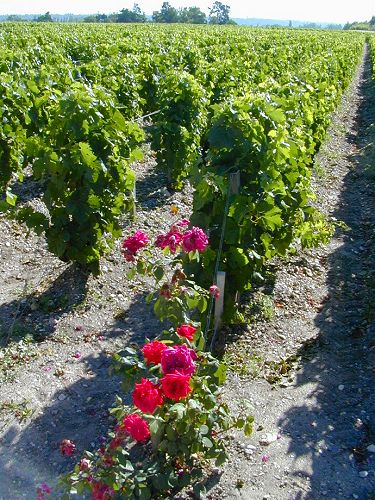 Grapes and Roses Grapes and RosesWe came to Bordeaux because we knew little about the most famous wine in the world. In the United States, French Bordeaux is a euphemism for something that is high quality and very expensive. Because of their cost, I had only tried a few of these amazing wines. We wanted to de-mystify the stigma of Bordeaux and in doing, educate our palettes a little more. The vines from this photo are from Chateau Palmer in the Margaux region. They plant roses at the head of the vines because roses are more fickle than grapes. Deficiencies in soil or pests are likely to show up on the roses first, allowing time to attend to the problem before it affects the vines. -- Scott |
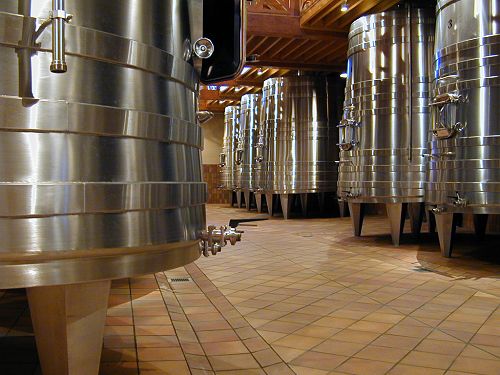 Fermentation Room Fermentation RoomBordeaux is a popular destination for wine buffs and tours of wineries must be set up in advance. I scheduled appointments for us at Chateau Palmer in Margaux, Mouton Rothschild in Pauillac and Haut-Brion in Pessac. This is the fermentation room at Chateau Palmer. It's in these stainless steel tanks that the process of making wine begins. They simply crush the grapes then dump them in these tanks and let the natural yeast on the grapes start the fermentation process - a very simple method that has been used for thousands of years. -- Scott |
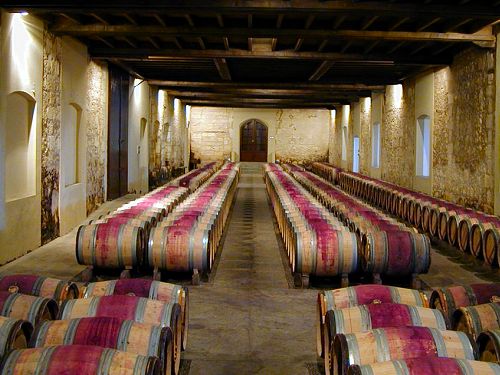 Barrel Room at Chateau Palmer Barrel Room at Chateau PalmerI stressed about taking our first chateau tour. Palmer is a high-end Bordeaux house. What's the etiquette here? Are we expected to buy wine?! I wondered. I knew we weren't going to splurge for any of their wine, and it made my stomach turn to think of the gaffe we might be committing. "Silly Americans, wanting a free tour," the chateau employees would laugh to one another, taking drags off their Gauloises on their lunch break. "What do they think this is, a brewery?" I needn't have fretted. The chateaus give the tours as a courtesy (a few charge for them). It's difficult enough to find the better wines anywhere, let alone buy it at the chateau. Like many Bordeaux houses, Palmer pre-sells each vintage well in advance of its actual release. An engaging, young French woman escorted us around the grounds, explaining the history of the chateau in charming, thickly accented English. After a taste of the still-in-barrel 2000 vintage, we were off to the next stop. -- Karen |
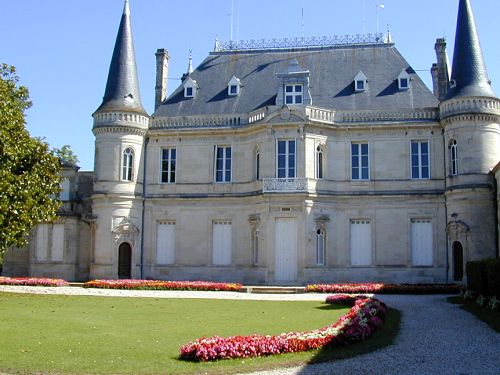 Chateau Palmer Chateau PalmerThis is the 'chateau' of Chateau Palmer. There are chateaus like this are all over the Bordeaux countryside and it makes for beautiful drives. Palmer is obviously not a French name - it's British in fact. Back in the early 1800's, after Napoleon's failed attempt at world domination, the Brits and Germans came in and bought many of the major wine producers at bargain basement prices. -- Scott |
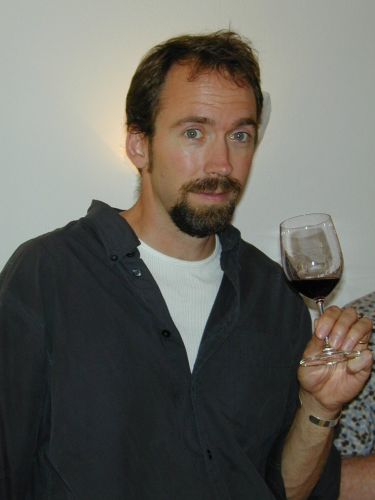 Good to the Last Drop Good to the Last DropWe also stopped at Chateau Mouton Rothschild, one of the five premier cru chateaus. After a comprehensive tour, we were again given a generous tasting of the 2000 vintage. Here's Scott, swirling, smiffing, assessing, and savoring. So what did it taste like? In my unprofessional opinion the wine was remarkably good, if a bit intense, out of the barrel, an inky purple-black, silky and almost thick on your tongue, tasting of the fruit, the caves, the oak, the vines, and the sunshine. -- Karen |
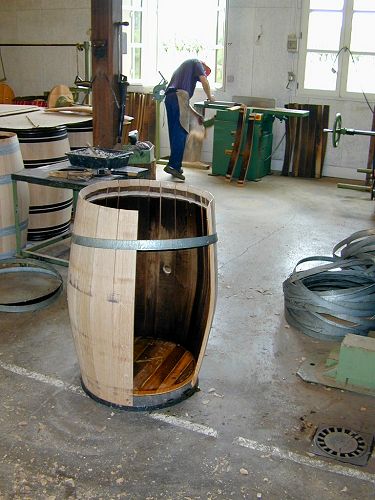 The Cooper The CooperAging wine in oak barrels imparts a great deal of flavor and every winery has it's own system for the process. Some use all French oak while others will also use American oak. Some use all new barrels while others will use a barrel for a number of years before replacing it. Finally, some wineries prefer to age in stainless steel so not to mask the true flavor of the wine. At Chateau Haut-Brion, they age exclusively in new French oak. Because the barrels are so important to the process they have their own cooperage so they can build and maintain them on site. -- Scott |
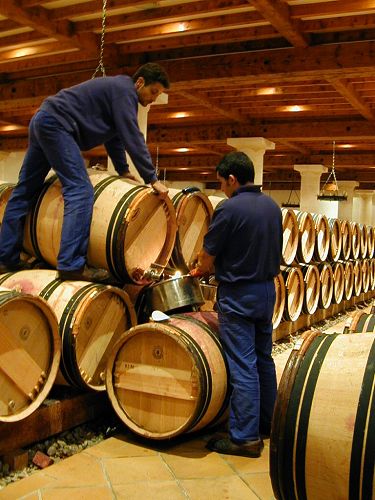 Racking the Wine Racking the WineThis is a picture of employees racking wine at Haut-Brion, another premier cru shop in Bordeaux. According to the Wine Spectator's online glossary, racking is "the practice of moving wine by hose from one container to another, leaving sediment behind. For aeration or clarification." The sediment is removed from the empty barrels, which are then refilled. Wine experts, including The Taste Bud himself, Robert Parker, agree that year 2000's Bordeaux harvest might just be one the finest Bordeaux vintages in decades. This is a big deal, because people pay lots of money for fine Bordeaux (upwards of $1,000 per bottle). So why are these houses pouring barrel tastings of the good stuff? I was puzzled. Could we be drinking the spillage from racking? It would make sense to catch perfectly good, run-off wine that could not go back into barrels (for reasons of hygiene, tradition, etc.), put it in bottles, and delight tourists by letting them taste it. Or maybe the wineries are just generous…. -- Karen |
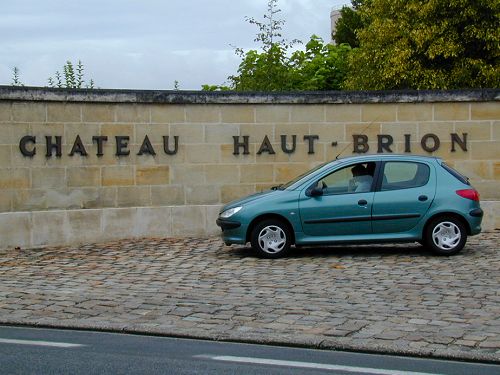 Peugeot Power Peugeot PowerSince we wanted to go to all the outlying vineyards, we rented a Peugeot 206 4-door diesel while we were in Bordeaux. It was fairly comfortable for 4 people and was pretty fun to drive. The diesels in Europe are not the loud, smoky diesels people think of in the United States. This one was quiet, had plenty of power, and got great mileage. This was a plus because even though diesel is less expensive then unleaded, it's still about $4 per gallon. This was the first time we had driven in Europe and it was fun trying to decipher all the strange street signs. This is a photo of us with the car in front of Chateau Haut-Brion. -- Scott |
Next Up: Paris
Copyright 2001
Scott & Karen Semyan